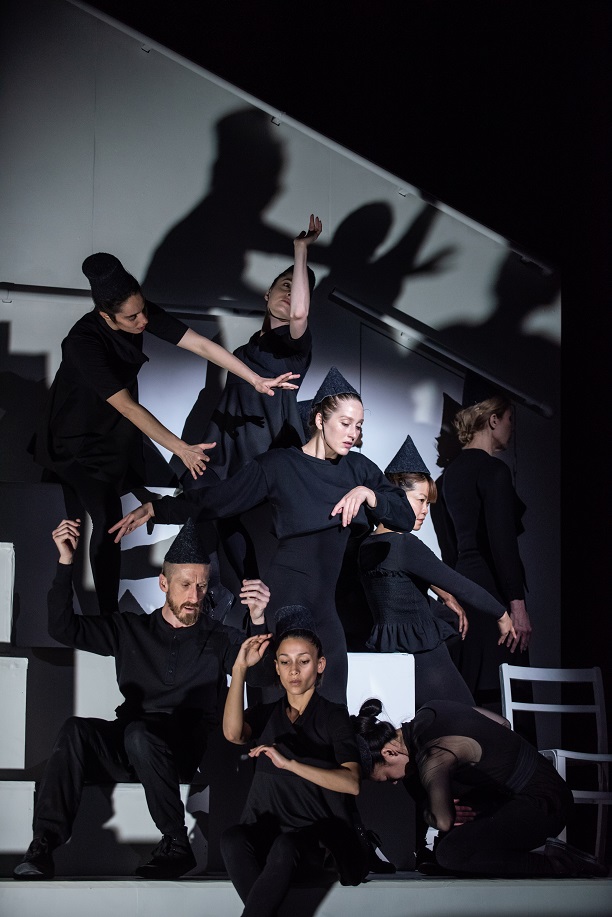Movement, Music & Light – A Review Of Clod Ensemble’s ‘On The High Road’
29th April, 2019


At Southbank Centre’s Queen Elizabeth Hall in London last week I was treated to an experience of utter otherworldliness and an inspirational insight to the human form and how when choreographed correctly, a show can align dance to music to create a story both thought-provoking and compelling.
Directed by Suzy Wilson and Paul Clark, ‘On The High Road’ follows the story of an eclectic mix of different people, all with various personalities and desires, and follows these people through a night of highs and lows amongst a claustrophobic monochrome set, stranded in a thunderstorm. Throughout the piece, pilgrims (as the cast members are known) come together, old or young, rich or poor to dream, dance, party and even fight as the night draws in on them.
The first thing that struck me about the show was the stark contrast between the colours of black and white. The monochrome background was apparently intentional according to the directors who stated that “when everything is black and white there is space for the audience to project their own lives onto it”. The black background and the white house in the front along with the kaleidoscopic flashing lights created a very immersive atmosphere, which when paired with the music, was almost haunting.

The first song that played mentioned “drinking, and politicians thinking”, which was a very subtle reference to the current world we live in. Paul Clark wrote the music and created a lot of it using samples from real life thunderstorms to create a very interesting dynamic for the show. Clark stated that the house was a “metaphor for an inn, a boat, a house, a city, the world!” and because of this, the political references are important, looking at how the show silently reflects the world we live in. We are currently experiencing problems with political issues and environmental disaster, and the show mirrors these issues silently, allowing us to draw our own conclusions from it.
There was a broad variety of music types used in the show, including contemporary, operatic, cabaret and even modern house music. Clark mentions that this was intentional to “have the differentiation amongst the pilgrims”. Each of the three acts had a different singer on stage, these including Thomas McCarthy, an Irish folk singer, soprano Melanie Pappenheim, and cabaret singer George Heyworth.
Pappenheim’s haunting vocals were the first to grab our attention and continued to carry through multiple scenes as the show went on. These served an exhilarating experience to the listener and really encapsulated your attention toward the performance, not allowing you to draw yourself away for a moment as Clark’s wonderfully crafted beats accompanied them.
For a while in the performance, in the left-hand corner of the stage, I could see a collapsed heap of a person, and I believed after some time for it to be a doll or dummy of some sort. Little did I know that it was going be one half of Bourgeois & Maurice, the amazing cabaret singer George Hayworth. Hayworth was the first person and only one in the whole performance to use any vocals at all, introducing themselves with a loud and clear “I’M AWAKE!” after a dream sequence. This upbeat scene covered in sparkles and a little joy was a refreshing moment in the story, one which I must say was my favourite in many ways. The first time I would say that I saw a true representation of variation amongst the people other than the change in hats that we see earlier in the performance.
The hats in the performance were worn by the actors as part of their costume. Many are in triangular ones, but some other characters enter the show later in square ones, this reflects the change and variety amongst people in a very clear way.
At the end of the show, I stayed for the Director’s chat with Radio 4 and McCarthy had the chance to talk a little bit about his performance and how it made him feel. McCarthy took to the stage last in the performance, dressed in a long bishop-like hat, really distinguishing himself from the rest of the cast and causing all but him to retreat to the bottom of the stage and he sat at the very top. This was an obvious symbolism of power and was extremely effective in showing a real-life example of politics. McCarthy’s voice was excellent, and the folk singing was so different to everything else in the show (also mirroring the diversity once again) and I loved it! McCarthy explained that he was from a travelling background who always sung unaccompanied without music, so the show was ever so slightly different from what he was used to. He was thinking due to this, that he didn’t know what would happen when singing along with the thunder and lightning. He said, “I never studied art or known much about it, but I’ve enjoyed it thoroughly and made lifelong friends” which was heart-warming to hear.

The show was 10 years in the making and was only rehearsed 3 weeks before being released on stage. There were multiple edits to the show but after the research and development processes, Wilson said the concept had been kept pretty much the same. Clark said that there had been a lot of experimentation with making the music especially and editing this had been a large piece of work, trying to choose which thunder crack to use and also trying out for a while a huge Bulgarian choir, but as amazing as this was, it took away from the desired contained vibe of the show. Even some of the club music that was used came from Clark’s ability to edit the thunder sounds he had chosen. Hizan, one of the actors, stated that the set made “you become one organism as you know you can’t move until someone has gone past you, like clockwork.”
The music that goes with the show is unfortunately not available as Clark stated that the music was designed to be immersive and there are 12 speakers that were inside the Southbank Centre making the music work effectively, so it would not be the same nor would it do the work justice if released on the usual stereo. However, he may consider it for the future so you may be able to get your hands on it soon enough!
If you get a chance to grab a glimpse of one of CLOD’s amazing award-winning performances, I would say that they are an eye-opening and very exciting exploration into the human form and the way it can move. It was an absolute delight to see, and I look forward to seeing their successes continue.
You can book ticketsfor ‘On The High Road’ in Doncaster on May 8th and the UK tour continues at
New Theatre Royal, Portsmouth: 15 & 16 May 2019
Oxford Playhouse: 20 & 21st May 2019
